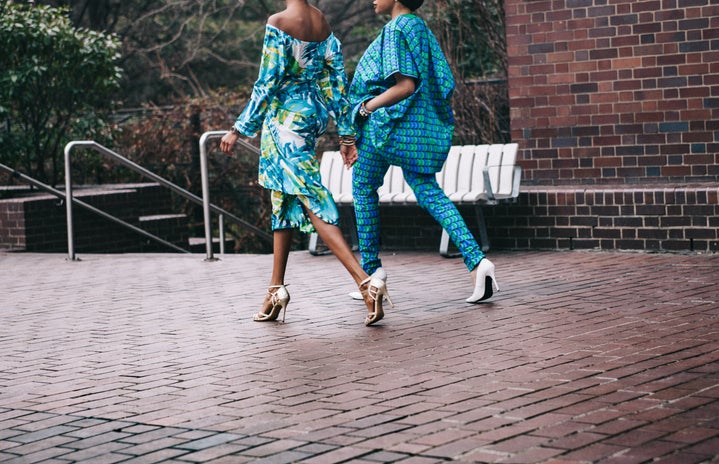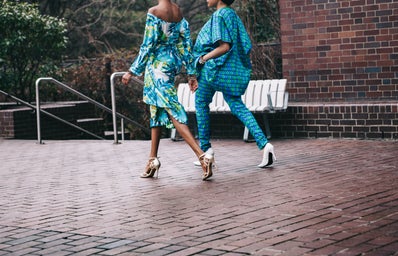The idea of producing and directing a fashion show seems glamorous in theory. However, those who have done it can tell you that it requires a lot of hard work and coordination. You need to find people to model the clothing, promote the event, find a venue and more. Each year, SynesthASIA produces a charity fashion show to raise funds for sustainable development and poverty alleviation projects throughout Asia. The fashion show’s director, Hana Bell has been planning this event for nearly a year, yet it seemed as though the tasks would never end. As a result Her Campus McGill decided to sit down with her and chat about fashion and the daily responsibilities of a fashion show director.Erica Ng for Her Campus McGill (HC McGill): How did you come about this opportunity to become the director of SynesthASIA and what made you take on this position?
Hana Bell (HB): I actually got the opportunity through one of my friends in Mosaica! She was the director for SynesthASIA in my first year, and she asked if I was available to help her with the project by acting as her Assistant Director. We collaborated a lot over the course of the year and she felt that I would be the best fit to take over as one of the next directors. I’ve always had a passion for the arts but charity work has been something that I hold close to my heart and believe is so important. Being of Asian descent, I can identify with a lot of the people we aim to help out, which is what makes SynesthASIA so unique and special to me.
HC McGill: What did you do to prepare for the show and the role as a director? Were there specific things you had to do?HB: The preparation for the show was a ton of work. As directors, Kristina and myself came up with the show theme (Dynasties), and talked to many venues in search for the perfect one. I also hosted model auditions and organized each model into a specific scene, organized jobs for the executives, managed the website and emails, organized bake sales and Gerts events, organized the executive photoshoot, set up the venue, choreographed the show, and of course directed and ushered the actual fashion show.
HC McGill: You must have a passion for fashion to some extent to run a fashion show. What does fashion mean to you and how would you describe your personal style?HB: Absolutely! I grew up with a strong passion for the arts, and I believe fashion is definitely a form of artistic expression because it is a timeless way of allowing us to express our unique identities without having to say anything. I love getting dressed up and take my inspiration from the things around me – mainly movies, books, people, fashions shows and blogs. I love putting together different outfits, particularly ones that involve a lot of layers. Recently my favourite fashion items have been my leather jacket from Wilfred and my 1920s oversized sunglasses – they are so versatile and make me feel more edgy because I usually gravitate towards more feminine pieces. I also used to work as a part-time model and watched a lot of America’s Next Top Model, so that industry definitely helped contribute to style sense as well. I love that SynesthASIA allows people who wouldn’t usually go to a fashion show explore and understand the world of fashion.
HC McGill: I know you grew up as a dancer and you’re even a dancer for Mosaica. I understand that most of the show was choreographed. Were there some difficulties with teaching others the choreography, especially those without formal dance training?HB: Yes – the entire show was choreographed, and Mosaica played a huge part in this process by helping me out with the choreography! The fact that every scene is uniquely choreographed is what sets SynesthASIA apart from other fashion shows. Part of the reason I’m so enthusiastic about SynesthASIA is because its a chance for me blend my lifelong passion of dancing with my love of fashion. I’m sure a lot of the models were frustrated with the choreography at times throughout the process, but they were all incredible sports and made the final show turn out better than I could have imagined, so thank you to all of them!
HC McGill: How many rehearsals did you have for this and for how long? More importantly, what were some of the behind the scene things that you had to do when preparing for these rehearsals?HB: We started rehearsals around February, and most scenes held weekly one-hour rehearsals up until show week. We also had one all-day rehearsal on the Sunday before the show. The all day rehearsal is always tedious but it is crucial because thats when models learn opening and closing scene, and it’s the only chance we have to run the show to make sure everything works okay, and for the models to see what the show will be like. I planned the scenes so that each scene could be choreographed by someone different. I wanted each scene to have its own distinct style in order to represent the cultural diversity we are exposed to here at McGill.
HC McGill: What were some of your favourite pieces during the show and what stood out the most about them?HB: This year we had an incredible student designer, Claire Peng, who designed and made an entire scene by herself. Each scene of our show this year encompassed a various Chinese Dynasty, and Claire’s scene was assigned the Han Dynasty. Claire chose to draw her inspiration from the Silk Road, which was created during the most prosperous period of the Han Dynasty. She did this by using bright silk fabrics and designing clothing that was more structured. All of Claire’s pieces stood out to both myself and the entire audience I think just because of how creative and well-made they were
HC McGill: Despite the fact that you’re a director, you obviously had to coordinate and collaborate with others to make it work. How did others help you with this process?HB: I could never have operated the entire show by myself, I had my co-director, Kristina, as well as 9 other committed executive members. We had executives designated to specific roles, but on the day of the show, everyone really helped each other and worked in all-encompassing roles. My Mosaica girls also helped me so much by taking on roles of both models and choreographers, and by helping me coordinate the 40 models in the show. The show also wouldn’t have happened without my roommate, best friend, and now co-director Brooke, who was technically the Charity Liaison this year but really did so much more than that.
HC McGill: What were some of the biggest challenges that you faced in this position? How did you go about solving them?HB: One of the biggest challenges was getting everything done in time for the show. As a very organized individual, I like to have everything prepared very early so that nothing goes wrong, but of course where something can go wrong, it will. Show week was hectic because we lost our hair and makeup crew, had a few models drop out of the show, had designers delay sending us their clothes until the day before the show, and had trouble setting up the stage at the venue. The craziness of show week was definitely the most demanding and challenging part, but it all came together in the end.
HC McGill: What was your favourite part of this experience and why?HB: My favourite part was by far the watching of the actual show. During the show I was up in the DJ booth ushering the show, so I was able to watch the whole thing. Watching the show all come together and seeing all the models work so cohesively made the clothes really come to life, and that was the most rewarding part of the experience, and definitely the reason I want to do it again next year!

